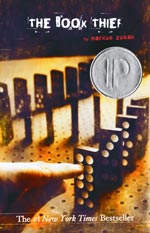
Rethinking the Label: Is YA Always for Kids?

Yet defining the boundary between adult fiction and young adult fiction can often be murky at best. Even if a main character is not quite an adult, does that have to direct a novel’s marketability towards teenagers? Knopf chose to market Zusak’s novel towards a younger audience, at least in the United States, but for a story set during the Holocaust in which Death serves as the narrator for the entire 550 pages, I can’t help but think there are themes which might be lost on younger readers.
And then there is also the prose, without doubt representing a fluidity of language with a compelling twist that had me hooked from the first chapter when Death introduces himself:
—Of course, an introduction.
A beginning.
Where are my manners?
I could introduce myself properly, but it’s not really necessary. You will know me well enough, and soon enough, depending on a diverse range of variables. It suffices to say that at some point in time, I will be standing over you, as genially as possible. Your soul will be in my arms. A color will be perched on my shoulder. I will carry you gently away.
At that moment, you will be lying there (I rarely find people standing up). You will be caked in your own body. There might be a discovery; a scream will dribble down the air. The only sound I’ll hear after that will be my own breathing, and the sound of the smell, of my footsteps.
The question is, what color will everything be at that moment when I come for you? What will the sky be saying?
Personally, I like a chocolate-colored sky. Dark, dark chocolate. People say it suits me. I do, however, try to enjoy every color I see—the whole spectrum. A billion or so flavors, none of them quite the same, and a sky to slowly suck on. It takes the edge off the stress. It helps me relax.
And with that introduction, I could not put down the story of Liesel, a child abandoned by a mother who cannot afford to care for her in the early days of Hitler’s Reich; the Hubermans, the childless couple who take her in; Rudy, the neighbor boy down the street with whom she falls in love; and Max, the Jew who eventually finds his way to Himmel Street. As the world collapses around her, Liesel sees not the events of the world—although Death reminds us of his increasingly busy schedule—but rather her great secret: she cannot read. Books are burned in Nazi Germany and 1938 gives way to 1939 with the coming storm of WWII, but we see Liesel discovering the magic of words and the beauty of language even as Death is the one who notes her progress.
Young adult? Hardly. Worth reading? Absolutely.
